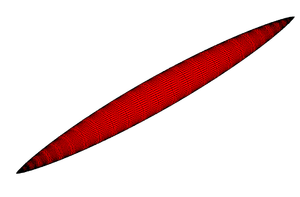Difference between revisions of "Sears-Haack body"
→Explanation |
|||
| Line 2: | Line 2: | ||
[[File:Sears-Haack.png|thumb|right|300px| A mathematically generated Sears-Haack body.]] | [[File:Sears-Haack.png|thumb|right|300px| A mathematically generated Sears-Haack body.]] | ||
Sears-Haack body is the theoretical fuselage design that produces the most efficient supersonic flight for a certain volume and diameter with the lowest possible [[wave drag]]. The area distribution is as smooth as possible and it follows a profile as shown in the picture. | Sears-Haack body is the theoretical fuselage design that produces the most efficient supersonic flight for a certain volume and diameter with the lowest possible [[wave drag]]. The area distribution is as smooth as possible and it follows a profile as shown in the picture. | ||
| + | |||
== Frequently Asked Questions == | == Frequently Asked Questions == | ||
=== Does the Sears-Haack body follow Whitcomb’s area rule? === | === Does the Sears-Haack body follow Whitcomb’s area rule? === | ||
No, it does not. The [[Whitcomb area rule|area rule]] finds its application in the reduction of wave drag at transonic speeds. Sears-Haack body is a theoretical shape for supersonic flow, derived from the Prandtl-Glauert equation, which itself is valid only in subsonic and supersonic flows and not in a transonic flow. | No, it does not. The [[Whitcomb area rule|area rule]] finds its application in the reduction of wave drag at transonic speeds. Sears-Haack body is a theoretical shape for supersonic flow, derived from the Prandtl-Glauert equation, which itself is valid only in subsonic and supersonic flows and not in a transonic flow. | ||
Revision as of 10:51, 19 November 2016
Explanation
Sears-Haack body is the theoretical fuselage design that produces the most efficient supersonic flight for a certain volume and diameter with the lowest possible wave drag. The area distribution is as smooth as possible and it follows a profile as shown in the picture.
Frequently Asked Questions
Does the Sears-Haack body follow Whitcomb’s area rule?
No, it does not. The area rule finds its application in the reduction of wave drag at transonic speeds. Sears-Haack body is a theoretical shape for supersonic flow, derived from the Prandtl-Glauert equation, which itself is valid only in subsonic and supersonic flows and not in a transonic flow.

